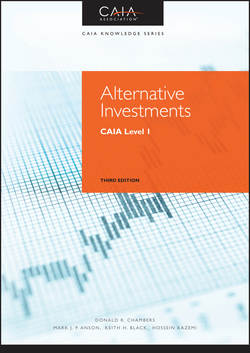Читать книгу Alternative Investments - Hossein Kazemi - Страница 67
На сайте Литреса книга снята с продажи.
PART One
Introduction to Alternative Investments
CHAPTER 4
Statistical Foundations
4.3 Covariance, Correlation, Beta, and Autocorrelation
4.3.5 Beta
ОглавлениеThe beta of an asset is defined as the covariance between the asset's returns and a return such as the market index, divided by the variance of the index's return, or, equivalently, as the correlation coefficient multiplied by the ratio of the asset volatility to market volatility:
(4.19)
where βi is the beta of the returns of asset i (Ri) with respect to a market index of returns, Rm. The numerator of the middle expression in Equation 4.19 measures the amount of risk that an individual stock brings into an already diversified portfolio. The denominator represents the total risk of the market portfolio. Beta therefore measures added systematic risk as a proportion of the risk of the index.
In the context of the capital asset pricing model (CAPM) and other single-factor market models, Rm is the return of the market portfolio, and the beta indicates the responsiveness of asset i to fluctuations in the value of the market portfolio. In the context of a single-factor benchmark, Rm would be the return of the benchmark portfolio, and the beta would indicate the responsiveness of asset i to fluctuations in the benchmark. In a multifactor asset pricing model, the beta indicates the responsiveness of asset i to fluctuations in the given risk factor, as is discussed in Chapter 6.
Exhibit 4.2 illustrates the computation of beta using a market index's return as a proxy for the market portfolio. Beta is similar to a correlation coefficient, but it is not bounded by +1 on the upside and −1 on the downside.
There are several important features of beta. First, it can be easily interpreted. The beta of an asset may be viewed as the percentage return response that an asset will have on average to a one-percentage-point movement in the related risk factor, such as the overall market. For example, if the market were to suddenly rise by 1 % in response to particular news, a fund with a market beta of 0.95 would be expected on average to rise 0.95 %, and a fund with a beta of 2.0 would be expected to rise 2 %. If the market falls 2 %, then a fund with a beta of 1.5 would have an expected decline of 3 %. But actual returns deviate from these expected returns due to any idiosyncratic risk. The risk-free asset has a beta of zero, and its return would therefore not be expected to change with movements in the overall market. The beta of the market portfolio is 1.0.
The second feature of beta is that it is the slope coefficient in a linear regression of the returns of an asset (as the Y, or dependent variable) against the returns of the related index or market portfolio (as the X, or independent variable). Thus, the computation of beta in Exhibit 4.2 using Equation 4.19 may be viewed as having identified the slope coefficient of the previously discussed linear regression. Chapter 9 discusses linear regression.
Third, because beta is a linear measure, the beta of a portfolio is a weighted average of the betas of the constituent assets. This is true even though the total risk of a portfolio is not the weighted average of the total risk of the constituent assets. This is because beta reflects the correlation between an asset's return and the return of the market (or a specified risk factor) and because the correlation to the market does not diversify away as assets are combined into a portfolio.
Similar to the correlation coefficient between the returns of two assets, the beta between an asset and an index is estimated rather than observed. An estimate of beta formed with historical returns may differ substantially from an asset's true future beta for a couple of reasons. First, historical measures such as beta are estimated with error. Second, the beta of most assets should be expected to change through time as market values change and as fundamental economic relationships change. In fact, beta estimations based on historical data are often quite unreliable, although the most reasonable estimates of beta that are available may be based at least in part on historical betas.
